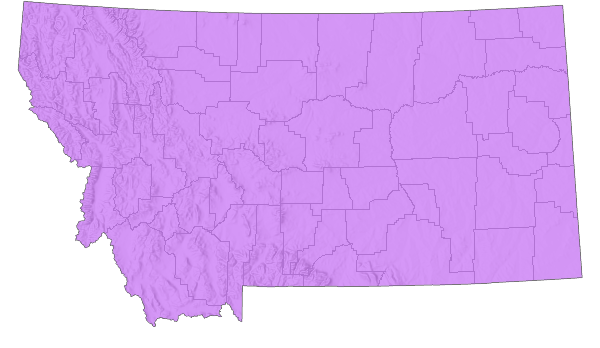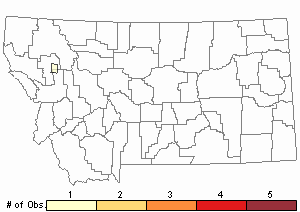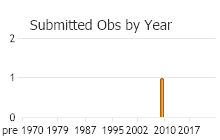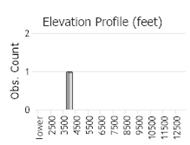View in other NatureServe Network Field Guides
NatureServe
Montana
Utah
Wyoming
Idaho
Wisconsin
British Columbia
South Carolina
Yukon
California
New York
Afranius Duskywing - Erynnis afranius
Native Species
Global Rank:
G5
State Rank:
S5
Agency Status
USFWS:
USFS:
BLM:
External Links
General Description
[From Ferris and Brown 1981; Scott 1986; Opler and Wright 1999; Glassberg 2001; Pyle 2002] Forewing 1.3-1.8 cm. Hindwing fringes pale-tipped. Upperside brownish-black, the forewing with scattering of flat white scales and several clear spots, not hairy. Male with brownish patch just distal to forewing cell, a costal fold containing yellow scent scales; female with a patch of scent scales on 7th abdominal segment.
Phenology
Two flights, mostly May to early August; several flights March to August in southern California (Scott 1986). March to May and late June to September (Glassberg 2001). April to May and July to September in the Rocky Mountain states (Ferris and Brown 1981), late April to late May and early July to early September in Colorado (Scott and Scott 1978), April to early June and early July to September in the Pacific Northwest (Pyle 2002).
Diagnostic Characteristics
The duskywing skippers (genus
Erynnis) can be a challenge to identify, particularly in prairie habitat where all three species may occur together. The white spots in the forewing tip are useful characters for separating these species.
The Afranius Duskwing and the Persius Duskywing (Erynnis persius) both have at least two (usually three or four) spots, while the Dreamy Duskywing (Erynnis icelus) has only one spot or none at all. The Afranius Duskywing is more difficult to separate from the Persius Duskywing. The Afranius Duskywing is more brown in colour, not grey, and the fore- and hindwing do not contrast grey (forewing) and grey-brown (hindwing) to the same extent that the Persius Duskywing does. Individuals from a short-grass prairie habitat in August are almost certainly the Afranius Duskywing, since the Persius Duskywing does not have a second brood (Schmidt no date). Uncertain specimens must be dissected for diagnostic characteristics of the male genitalia; see Scott (1986) and Guppy and Shepard (2001) for illustrations.
Species Range
Montana Range
Range Descriptions

 Native
Native
Range Comments
Southern Alberta south in Rocky Mountain states to central Mexico, west in the north to northern Idaho, in the south through northern New Mexico and northern Arizona to southern California, east to southern Saskatchewan and Manitoba, western Dakotas, western Nebraska, the high prairies of Colorado and New Mexico; isolated population in central Alaska and adjacent Yukon Territory (Scott 1986; Opler and Wright 1999; Glassberg 2001); usually below 2438 m elevation in the Rocky Mountain states (Ferris and Brown 1981), 1676 m to 2134 m elevation Colorado, but reported to 3658 m (Brown 1957; Scott and Scott 1978). In Montana, reported from across the state in at least 40 counties (Kohler 1980; Stanford and Opler 1993; FLMNH Lepidopterists' Society database), to at least 1311 m elevation, but Kohler (personal communication, 5 March 2017) states "It has not been recorded from west of the Divide. Many E. persius have been misidentified as E. afranius." Considered a relict of extensive montane coniferous forest climax in the western Great Plains following recession of the Pleistocene glaciers (Johnson 1975). Uncomon to common (Glassberg 2001).
Observations in Montana Natural Heritage Program Database
Number of Observations: 1
(Click on the following maps and charts to see full sized version)
Map Help and Descriptions
Relative Density

Recency



 (Observations spanning multiple months or years are excluded from time charts)
(Observations spanning multiple months or years are excluded from time charts)
Migration
Non-migratory.
Habitat
Prairie hills, canyons, badlands, chaparral, open conifer woodlands, meadows, edges, stream corridors, tundra (Johnson 1975; Scott 1986; Opler and Wright 1999; Glassberg 2001). Habitat in Montana not described but probably similar.
Food Habits
Larval food plants are various legumes including Astragalus (multiple species), Lotus, Lupinus (multiple species), and Thermopsis (Ferris and Brown 1981; Scott 1986, 1992, 2006; Pyle 2002). Adults feed on flower nectar (including Allium, Apocynum, Campanula, Cirsium, Convolvylus, Grindelia, Heterotheca, Hymenoxys, Lathyrus, Lesquerella, Lupinus, Marrubium, Medicago, Melilotus, Monarda, Oxytropis, Penstemon, Psoralea, Senecio, Solidago, Symphoricarpos, Taraxacum, Thermopsis, Thlaspi, Verbena) and mud (Scott 1986, 2014).
Reproductive Characteristics
Limited information. Females lay eggs singly on the undersides of host plant leaves, mostly near base of young leaves. Larvae eat host plant leaves, live in nests of rolled or silk-tied leaves, develop to mature larvae (L4 or L5 instar), hibernate (overwinter) as mature larvae (in a leaf nest), pupate between leaves tied with silk (Scott 1986, 1992, 2006). Males perch all day in gullies and swales awating passing females (Scott 1975b, 1986).
Stewardship Responsibility
References
- Literature Cited AboveLegend:
 View Online Publication
View Online Publication Bird, C.D., G.I. Hilchie, N.G. Kondla, E.M. Pike, and F.A.H. Sperling. 1995. Alberta Butterflies. The Provincial Museum of Alberta, Edmonton. 349 pp.
Bird, C.D., G.I. Hilchie, N.G. Kondla, E.M. Pike, and F.A.H. Sperling. 1995. Alberta Butterflies. The Provincial Museum of Alberta, Edmonton. 349 pp. Brown, F.M. 1957. Colorado Butterflies. Proceedings; Numbers Three through Seven. Denver Museum of Natural History, Denver, Co.
Brown, F.M. 1957. Colorado Butterflies. Proceedings; Numbers Three through Seven. Denver Museum of Natural History, Denver, Co. Ferris, C.D. and F.M. Brown (eds). 1981. Butterflies of the Rocky Mountains. Univ. of Oklahoma Press. Norman. 442 pp.
Ferris, C.D. and F.M. Brown (eds). 1981. Butterflies of the Rocky Mountains. Univ. of Oklahoma Press. Norman. 442 pp. Glassberg, J. 2001. Butterflies through Binoculars: A Field Guide to the Butterflies of Western North America. Oxford University Press.
Glassberg, J. 2001. Butterflies through Binoculars: A Field Guide to the Butterflies of Western North America. Oxford University Press. Guppy, C.S. and J.H. Shepard. 2001. Butterflies of British Columbia: including western Alberta, southern Yukon, the Alaska Panhandle, Washington, northern Oregon, northern Idaho, northwestern Montana. UBC Press (Vancouver, BC) and Royal British Columbia Museum (Victoria, BC). 414 pp.
Guppy, C.S. and J.H. Shepard. 2001. Butterflies of British Columbia: including western Alberta, southern Yukon, the Alaska Panhandle, Washington, northern Oregon, northern Idaho, northwestern Montana. UBC Press (Vancouver, BC) and Royal British Columbia Museum (Victoria, BC). 414 pp. Johnson, K. 1975. Post-Pleistocene environments and montane butterfly relicts on the western Great Plains. Journal of Research on the Lepidoptera 14(4): 216-232.
Johnson, K. 1975. Post-Pleistocene environments and montane butterfly relicts on the western Great Plains. Journal of Research on the Lepidoptera 14(4): 216-232. Kohler, S. 1980. Checklist of Montana Butterflies (Rhopalocera). Journal of the Lepidopterists' Society 34(1): 1-19.
Kohler, S. 1980. Checklist of Montana Butterflies (Rhopalocera). Journal of the Lepidopterists' Society 34(1): 1-19. Kohler, S. 2017. Personal communication via email, with attached word document titled 'Montana Field Guide Review.' 5 March 2017.
Kohler, S. 2017. Personal communication via email, with attached word document titled 'Montana Field Guide Review.' 5 March 2017. McCabe, T.L. 1977. Aberrant (Speyeria idalia). Journal of Research of the Lepidoptera 16(1):68.
McCabe, T.L. 1977. Aberrant (Speyeria idalia). Journal of Research of the Lepidoptera 16(1):68. Opler, P.A. and A.B. Wright. 1999. A field guide to western butterflies. Second edition. Peterson Field Guides. Houghton Mifflin Company, Boston, Massachusetts. 540 pp.
Opler, P.A. and A.B. Wright. 1999. A field guide to western butterflies. Second edition. Peterson Field Guides. Houghton Mifflin Company, Boston, Massachusetts. 540 pp. Opler, P.A., K. Lotts, and T. Naberhaus, coordinators. 2010. Butterflies and moths of North America. Big Sky Institute, Bozeman, MT. Available at: www.butterfliesandmoths.org (Accessed 15 June 2015).
Opler, P.A., K. Lotts, and T. Naberhaus, coordinators. 2010. Butterflies and moths of North America. Big Sky Institute, Bozeman, MT. Available at: www.butterfliesandmoths.org (Accessed 15 June 2015). Pyle, R.M. 2002. The butterflies of Cascadia: a field guide to all the species of Washington, Oregon, and surrounding territories. Seattle Audubon Society, Seattle, Washington. 420 pp.
Pyle, R.M. 2002. The butterflies of Cascadia: a field guide to all the species of Washington, Oregon, and surrounding territories. Seattle Audubon Society, Seattle, Washington. 420 pp. Scott, J.A. 1975b. Mate-locating behavior of western North American butterflies. Journal of Research on the Lepidoptera 14:1-40.
Scott, J.A. 1975b. Mate-locating behavior of western North American butterflies. Journal of Research on the Lepidoptera 14:1-40. Scott, J.A. 1986. The butterflies of North America: a natural history and field guide. Stanford University Press, Stanford, California.
Scott, J.A. 1986. The butterflies of North America: a natural history and field guide. Stanford University Press, Stanford, California. Scott, J.A. 1992. Hostplant records for butterflies and skippers (mostly from Colorado) 1959-1992, with new life histories and notes on oviposition, immatures, and ecology. Papilio new series #6. 185 p.
Scott, J.A. 1992. Hostplant records for butterflies and skippers (mostly from Colorado) 1959-1992, with new life histories and notes on oviposition, immatures, and ecology. Papilio new series #6. 185 p. Scott, J.A. 2006. Butterfly hostplant records, 1992-2005, with a treatise on the evolution of Erynnis, and a note on new terminology for mate-locating behavior. Papilio new series #14. 74 p.
Scott, J.A. 2006. Butterfly hostplant records, 1992-2005, with a treatise on the evolution of Erynnis, and a note on new terminology for mate-locating behavior. Papilio new series #14. 74 p. Scott, J.A. 2014. Lepidoptera of North America 13. Flower visitation by Colorado butterflies (40,615 records) with a review of the literature on pollination of Colorado plants and butterfly attraction (Lepidoptera: Hersperioidea and Papilionoidea). Contributions of the C.P. Gillette Museum of Arthopod Diversity. Fort Collins, CO: Colorado State University. 190 p.
Scott, J.A. 2014. Lepidoptera of North America 13. Flower visitation by Colorado butterflies (40,615 records) with a review of the literature on pollination of Colorado plants and butterfly attraction (Lepidoptera: Hersperioidea and Papilionoidea). Contributions of the C.P. Gillette Museum of Arthopod Diversity. Fort Collins, CO: Colorado State University. 190 p. Scott, J.A. and G.R. Scott. 1978. Ecology and distribution of the butterflies of southern central Colorado. Journal of Research on the Lepidoptera 17(2): 73-128.
Scott, J.A. and G.R. Scott. 1978. Ecology and distribution of the butterflies of southern central Colorado. Journal of Research on the Lepidoptera 17(2): 73-128. Stanford, R.E. and P.A. Opler. 1993. Atlas of western USA butterflies: including adjacent parts of Canada and Mexico. Unpubl. Report. Denver and Fort Collins, Colorado 275 pp.
Stanford, R.E. and P.A. Opler. 1993. Atlas of western USA butterflies: including adjacent parts of Canada and Mexico. Unpubl. Report. Denver and Fort Collins, Colorado 275 pp.
- Additional ReferencesLegend:
 View Online Publication
View Online Publication
Do you know of a citation we're missing? Allen, T.J., J.P. Brock, and J. Glassberg. 2005. Caterpillars in the field and garden: a field guide to the butterfly caterpillars of North America. Oxford University Press.
Allen, T.J., J.P. Brock, and J. Glassberg. 2005. Caterpillars in the field and garden: a field guide to the butterfly caterpillars of North America. Oxford University Press. Brock, J.P. and K. Kaufman. 2003. Kaufman Field Guide to Butterflies of North America. Houghton Mifflin Company, New York, NY 284 pp.
Brock, J.P. and K. Kaufman. 2003. Kaufman Field Guide to Butterflies of North America. Houghton Mifflin Company, New York, NY 284 pp. Forister, M.L., C.A. Halsch, C.C. Nice, J.A. Fordyce, T.E. Dilts, J.C. Oliver, K.L. Prudic, A.M. Shapiro, J.K. Wilson, J. Glassberg. 2021. Fewer butterflies seen by community scientists across the warming and drying landscapes of the American West. Science 371:1042-1045.
Forister, M.L., C.A. Halsch, C.C. Nice, J.A. Fordyce, T.E. Dilts, J.C. Oliver, K.L. Prudic, A.M. Shapiro, J.K. Wilson, J. Glassberg. 2021. Fewer butterflies seen by community scientists across the warming and drying landscapes of the American West. Science 371:1042-1045. Forister, M.L., E.M. Grames, C.A. Halsch, K.J. Burls, C.F. Carroll, K.L. Bell, J.P. Jahner, et al. 2023. Assessing risk for butterflies in the context of climate change, demographic uncertainty, and heterogeneous data sources. Ecological Monographs 93(3):e1584. https://doi.org/10.1002/ecm.1584
Forister, M.L., E.M. Grames, C.A. Halsch, K.J. Burls, C.F. Carroll, K.L. Bell, J.P. Jahner, et al. 2023. Assessing risk for butterflies in the context of climate change, demographic uncertainty, and heterogeneous data sources. Ecological Monographs 93(3):e1584. https://doi.org/10.1002/ecm.1584 Layberry, R.A., P.W. Hall, and J.D. LaFontaine. 1998. The Butterflies of Canada. University of Toronto Press. 280 pp. + color plates.
Layberry, R.A., P.W. Hall, and J.D. LaFontaine. 1998. The Butterflies of Canada. University of Toronto Press. 280 pp. + color plates.
- Web Search Engines for Articles on "Afranius Duskywing"
- Additional Sources of Information Related to "Insects"





